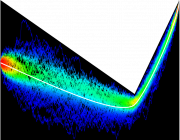Citation:
Taillefumier T, Magnasco M. A Transition to Sharp Timing in Stochastic Leaky Integrate-and-Fire Neurons Driven by Frozen Noisy Input. Neural Computation [Internet]. 26 (5) :819 – 859.
Abstract
The firing activity of intracellularly stimulated neurons in cortical slices has been demonstrated to be profoundly affected by the temporal structure of the injected current (Mainen & Sejnowski, 1995). This suggests that the timing features of the neural response may be controlled as much by its own biophysical characteristics as by how a neuron is wired within a circuit. Modeling studies have shown that the interplay between internal noise and the fluctuations of the driving input controls the reliability and the precision of neuronal spiking (Cecchi et al., 2000; Tiesinga, 2002; Fellous, Rudolph, Destexhe, & Sejnowski, 2003). In order to investigate this interplay, we focus on the stochastic leaky integrate-and-fire neuron and identify the Hölder exponent H of the integrated input as the key mathematical property dictating the regime of firing of a single-unit neuron. We have recently provided numerical evidence (Taillefumier & Magnasco, 2013) for the existence of a phase transition when H becomes less than the statistical Hölder exponent associated with internal gaussian white noise (H=1/2). Here we describe the theoretical and numerical framework devised for the study of a neuron that is periodically driven by frozen noisy inputs with exponent H>0. In doing so, we account for the existence of a transition between two regimes of firing when H=1/2, and we show that spiking times have a continuous density when the Hölder exponent satisfies H>1/2. The transition at H=1/2 formally separates rate codes, for which the neural firing probability varies smoothly, from temporal codes, for which the neuron fires at sharply defined times regardless of the intensity of internal noise.


